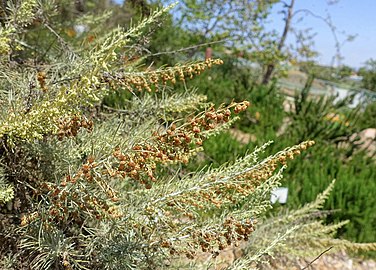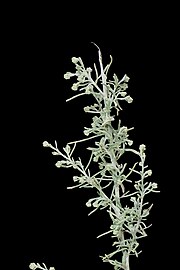| Artemisia californica | |
|---|---|

| |
| Artemisia californica in Gaviota State Park, California | |
| Conservation status | |
 Apparently Secure (NatureServe) | |
| Scientific classification | |
| Kingdom: | Plantae |
| Clade: | Tracheophytes |
| Clade: | Angiosperms |
| Clade: | Eudicots |
| Clade: | Asterids |
| Order: | Asterales |
| Family: | Asteraceae |
| Genus: | Artemisia |
| Species: | A. californica |
| Binomial name | |
| Artemisia californica Less. | |
| Synonyms | |
| |
Artemisia californica, also known as California sagebrush, is a species of western North American shrub in the sunflower family.
In the western United States, California sagebrush is grown in native plant gardens and as a drought-resistant landscaping choice. In addition to its drought resistance and capacity to draw pollinators like bees and butterflies, its silvery foliage is popular with gardeners and horticulturists.
Description
Artemisia californica branches from the base and grows out from there, becoming rounded; it grows 1.5 to 2.5 metres (5 to 8 feet) tall. The stems of the plant are slender, flexible, and glabrous (hairless) or canescent (fuzzy). The leaves range from 1 to 10 centimetres (1⁄2 to 4 inches) long and are pinnately divided with 2–4 threadlike lobes less than 5 cm long. Their leaves are hairy and light green to gray in color; the margins of the leaves curl under.
The inflorescences are leafy, narrow, and sparse. The capitula are less than 5 millimetres (3⁄16 in) in diameter. The pistillate flowers range in number from 6 to 10 and the disk flowers range from 15 to 30; they are generally yellowish, but sometimes red.
Artemisia species are sunflower (Asteraceae) family members, however unlike many other members of the family, they often produce small, unnoticeable blooms. Their attractive silvery leaf, which is often fragrant when crushed, is their strongest feature in the garden. The often pleasing perfume of the stems and leaves is caused by essential oils, which also deters animal and insect pests. They are an essential source of food for local wildlife because they flower late in the season. The genus Artemisia is widespread in the Old and New Worlds, and many species have been utilized for hundreds of years in Europe, Asia, and the Americas in horticulture, cooking, and medicine.
California sagebrush is sometimes confused for a true sage (Salvia) due to its common name and leaves that smells like sage. It is a crucial part of the community of coastal sage scrub habitat and is frequently widely utilized in restoration initiatives. When planted in full sun, it can reach heights and widths of roughly 4' and 4'. Once established, it may survive without additional water, but will appear happier when watered occasionally in the deep summer. Sagebrush's beautifully split gray leaves contrast nicely with the garden's lush green vegetation.
The fruits produced are resinous achenes up to 1.5 mm long. There is a pappus present that forms a minute crown on the achene body.
The plant contains terpenes which make it quite aromatic. Many people regard the species as having a pleasant smell.
-
 Young green foliage
Young green foliage
-
 Specimen in Manhattan Beach Botanical Garden
Specimen in Manhattan Beach Botanical Garden
-
 Close-up of foliage with dry flowers
Close-up of foliage with dry flowers
-
Mature gray foliage
-
 Close-up of mature foliage
Close-up of mature foliage
-
 Seeds and spent pseudanthia of Artemisia californica
Seeds and spent pseudanthia of Artemisia californica
Distribution and habitat
The shrub is native to western California and northwestern Baja California. It is endemic to the California chaparral and woodlands ecoregion, in coastal sage scrub, coastal strand, chaparral, and dry foothill communities. It is found from sea level to 800 m (2,600 ft) in elevation. This species is also found on many islands adjacent to the Baja California peninsula, including the Coronado Islands and Cedros Island. It is even found on Guadalupe Island, in the Pacific Ocean.
The prototypical plant association of A. californica is chaparral, notably in the California Coast Ranges; toyon and sage are also key components of communities which are transitional between chaparral and coastal sage scrub. It is often claimed to be allelopathic, secreting chemicals into the ground which inhibit other plants from growing near and around the shrub.
Cultivation
This shrub is cultivated as an ornamental plant in native plant and wildlife gardens, natural landscaping design, and for restoration of disturbed sites and degraded coastal sage scrub. There are several lower height cultivars in the horticulture trade, for drought-tolerant groundcover use.
It thrives in full sun, preferring to grow on west or north-facing slopes. It needs little water and prefers no water in the summer months; it does not seem that soil types affect plant growth much. This plant relies on wildfire for seed germination and burned plants can crown-sprout and keep growing.
Animals rarely eat Artemisia californica, probably due to the presence of bitter aromatic terpenes, but it does provide good cover for smaller birds and other animals that can fit between its stems. It is an important habitat plant for the endangered California gnatcatcher.
Uses
Medicinal
The Cahuilla natives employ the plant as a treatment to fight coughs and colds. They chew the leaves, either dried or fresh. It is used by women of the Cahuilla and Tongva to alleviate menstrual cramps and to ease labor. The plant stimulates the uterine mucosa, which quickens childbirth. It is also made into a decoction, and if taken regularly prior to menstruation, it relieves menstrual cramps and menopause. The Ohlone use it as a pain remover by applying the leaves to wounds or teeth. It is also made into a tea bath to cure colds, coughs, and rheumatism. It is used as a poultice for asthma as well. Its aromatic qualities also make it valuable for incense and perfumes. Today, it continues to be used in native landscaping, providing not only aesthetic appeal but also a link to indigenous traditions.
A. californica is used to make a liniment that is a powerful pain reliever. The monoterpenoids in the plant interact with transient receptor potential cation channels to relieve pain. The plant also contains sesquiterpenes that may be involved in pain relief. The liniment is more powerful than opioid drugs and is much safer. A small amount of the liniment is applied where it is needed. Within 20 minutes, the pain subsides, even pain from broken bones, arthritis, sprains and strains.
Conservation Issues & Efforts
There are various conservation issues with California sagebrush. Threats to its natural habitat include exotic species, habitat fragmentation, and urban development. In recognition of the significance of Artemisia californica in preserving biodiversity, efforts are being made to conserve and restore the coastal sage scrub environment.
Numerous conservation initiatives have been started as a result of the California sagebrush's significance in coastal habitats. Projects aiming at preserving habitat and restoring the coastal sage scrub ecosystem are among them. These conservation activities must include invasive species management tactics, awareness-raising campaigns, and community involvement.
See also
References
- "NatureServe Explorer 2.0". explorer.natureserve.org. Retrieved 2023-10-23.
- The Plant List Artemisia californica Less.
- ^ "Artemisia californica in Flora of North America @ efloras.org". www.efloras.org. Retrieved 2020-10-04.
- Blogger, CNPS (2012-03-23). "Artemisia in the Garden". California Native Plant Society. Retrieved 2023-10-25.
- ^ "Artemisia californica". www.fs.fed.us. Retrieved 2020-10-04.
- Native Salvias and Artemisias MyMotherLode.com October 15, 2006
- Rebman, J. P.; Gibson, J.; Rich, K. (2016). "Annotated checklist of the vascular plants of Baja California, Mexico" (PDF). San Diego Society of Natural History. 45: 44.
- "C. Michael Hogan, (2008) Toyon (Heteromeles arbutifolia), GlobalTwitcher, ed. N. Stromberg". Archived from the original on 2009-07-19. Retrieved 2008-11-27.
- "Artemisia californica, California Sagebrush". www.laspilitas.com. Retrieved 2020-10-04.
- "BRIT - Native American Ethnobotany Database". naeb.brit.org. Retrieved 2020-10-04.
- ^ "Artemisia californica" (PDF). fs.fed.us. February 2016.
- "International Programs | US Forest Service". www.fs.usda.gov. February 2016. Retrieved 2020-10-04.
- Adams, James (2012). "The Use of California Sagebrush (Artemisia californica) Liniment to Control Pain". Pharmaceuticals. 5 (10): 1045–53. doi:10.3390/ph5101045. PMC 3816656. PMID 24281255.
- Adams, James David Jr. "What can traditional healing do for modern medicine." Tang 4.2 (2014): 3. pag.
- Hickson, D. E., Chan, M. L., Groenendyk, D., & Safford, H. D. (2017). Quantifying vegetation change within the Southern California coastal sage scrub monitoring network. Ecological Indicators, 77, 212-224.
External links
- Calflora Database: Artemisia californica (California sagebrush, Coast sagebrush)
- Jepson Manual eFlora (TJM2) treatment of Artemisia californica
- USDA Plants Profile for Artemisia californica (coastal sagebrush)
- UC Photos gallery: Artemisia californica
| Taxon identifiers | |
|---|---|
| Artemisia californica |
|
- NatureServe apparently secure species
- Artemisia (genus)
- Flora of California
- Flora of Baja California
- Flora of Guadalupe Island
- Natural history of the California chaparral and woodlands
- Natural history of the California Coast Ranges
- Natural history of the Channel Islands of California
- Natural history of the San Francisco Bay Area
- Natural history of the Santa Monica Mountains
- Natural history of the Peninsular Ranges
- Natural history of the Transverse Ranges
- Plants described in 1831
- Plants used in traditional Native American medicine
- Garden plants of North America
- Drought-tolerant plants